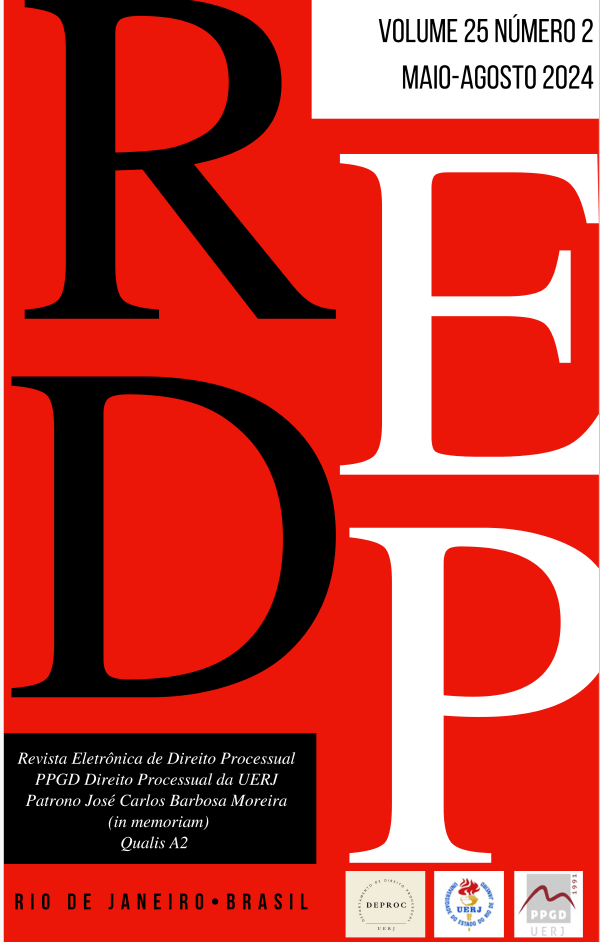A PROCEDURALIZAÇÃO COMO LEGITIMAÇÃO DA DECISÃO JUDICIAL: PELA COERÊNCIA SISTÊMICA DO DIREITO NAS DECISÕES DOS TRIBUNAIS
DOI:
https://doi.org/10.12957/redp.2024.85240Abstract
The interpretation and application of law assumes a central space in the current debates of jurists, searching for the controllability of judicial decisions, judicial voluntarism, discretion and/or arbitrariness of the judge. Taking the Law as a language system and one of the social subsystems, the procedural systemic normative construction is proposed as legitimizing the judicial decision, resulting from an indispensable combination of the attribution of meaning to the text of the law to the pragmatics of communication and dialogue of the normative discourses. Based on the theoretical assumptions of Logical-Semantic Constructivism, using a deductive analytical method, it exposes the interpreter's relational, cognitive process, through which signs are assimilated, through the idea generated by the association between the object and the sign, performed even by semiosis; one transits through pragmatics, where the interpreter accesses the facts, typifying them. It is concluded that the construction of the meaning of the norm takes place in a certain context and is subject to mutations due to the evolution of Law, in the dialogism between the social and the legal; Included in procedural dynamics are legal decisions that are valid to regulate certain conducts, which must be harmonious, non-contradictory, especially when endowed with a general and abstract claim, such as the rules of precedent.
Downloads
Published
How to Cite
Issue
Section
License
Copyright (c) 2024 Adriano Luiz Batista Messias, Liana Carine Fernandes de Queiroz

This work is licensed under a Creative Commons Attribution 4.0 International License.
Todos os artigos publicados na Revista Eletrônica de Direito Processual (REDP) (Departamento de Direito Processual, Universidade do Estado do Rio de Janeiro, Brasil) são licenciados por meio de uma Licença Creative Commons - Atribuição 4.0 Internacional (CC BY 4.0).
Os autores retêm os direitos autorais de seu artigo e concordam em licenciar seu trabalho com a licença CC BY 4.0, aceitando assim os termos e condições específicos desta licença disponíveis no seguinte website: https://creativecommons.org/licenses/by/4.0/legalcode.
- Os autores concedem à REDP o direito de primeira publicação, de se identificar como publicadora original do trabalho e concedem à revista uma licença de direitos não exclusivos para utilizar o trabalho das seguintes formas: Reproduzir, vender e distribuir cópias eletrônicas ou impressas do manuscrito como um todo, de partes específicas do manuscrito e de suas traduções para qualquer idioma;
- O uso do artigo por terceiros é livre, contanto que a integridade da publicação seja mantida e seus autores originais, periódico de primeira publicação e detalhes de citação sejam identificados.
Dentro dos termos da licença, os autores podem entrar em acordos contratuais adicionais separados para a distribuição não exclusiva da versão publicada do trabalho na revista.
Copyright and Licensing
All articles published in the Procedural Law Electronic Review (REDP) (Department of Procedural Law, State University of Rio de Janeiro, Brazil) are licensed under a Creative Commons License - Attribution 4.0 International (CC BY 4.0).
- Authors retain copyright to their article and agree to license their work under the CC BY 4.0 license, thereby accepting the specific terms and conditions of this license available at the following website: https://creativecommons.org/licenses/by/4.0/ legal code.
- Authors grant REDP the right of first publication, to identify itself as the original publisher of the work, and grant the journal a non-exclusive license to use the work in the following ways: Reproduce, sell and distribute electronic or printed copies of the manuscript as a whole, of specific parts of the manuscript and its translations into any language;
- Use of the article by third parties is free, as long as the integrity of the publication is maintained and its original authors, first publication journal, and citation details are identified.
Within the terms of the license, authors may enter into separate additional contractual agreements for the non-exclusive distribution of the published version of the work in the journal.




